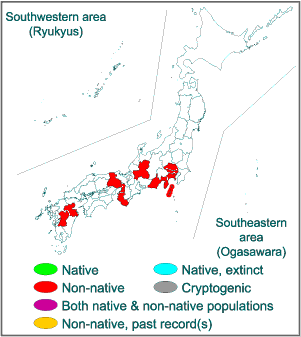
 Japanese |
English
Japanese |
English- Invasive Species of Japan >
- Mammals >
- Callosciurus erythraeus subspp.
| Invasion information | ||
| Range in Japan | Kanagawa Pref. (SE), Shizuoka Pref. (Izu Peninsula and Hamamtsu), Gifu Pref.(Mt. Kinkazan), Osaka Pref.(Osaka Castle Park), Wakayama Pref.(Wakayama Castle Park and Tomogashima Is.), Oita Pref. (Takashima Is.), Nagasaki Pref. (Iki and Fukue Is.), Kumamoto Pref. (Uto Peninsula), and Izuoshima Is. (Izu Islands), Tokyo Metro (Akiruno city), Saitama Pref. (Iruma city) |

|
| Origin | From Taiwan to Izuoshima. From Izuoshima to Enoshima and Tomogahima of Kanagawa and Wakayama Prefs. According to DNA analyses, Izu Peninsula and Fukuejima Is. populations were close to Taiwanese populations, whereas Hamamatsu population may be from continental China (or possibly hybrid with anothe congener). | |
| Date | The first record of escape was in 1935, in Izuoshima Is., Izu Islands. In other region, Enoshima, Kanagawa Pref.: 1951; Tomogashima Is., Wakayama Pref.: 1954; Kinkazan, Gifu Pref.: 1955; Takashima Is., Oita Pref.: 1959; Osaka, Himeji, Hyogo, and Hamamatsu: 1970s; Izu Peninsula, Fukuejima Is., and Iki: 1980s; Uto Peninsula, Kumamoto Pref.: 2008; Akiruno, Tokyo Metro. and Iruma, Saitama Pref.: 2011. | |
| Route | Deliberate: Intentional release or escape from zoo | |
| Impact | Actually: Damage on human house, electric cable, etc. Damage on vegetation. Damage on agriculture. Potentially: Competitive with native sciurid animals. Native organism(s) affected: Sciurid mammals, birds, insects, trees, vegetation, and crops. | |
| Regulation in Japan | Import, transport and keeping are prohibited by the Invasive Alien Species Act. | |
| Introduced range in other countries | Argentina, France, Belgium, Italy, Netherlands | |
| Reference | Notes |
|
All the species of Callosciurus (except C. erythraeus) are designated as Uncategorized Alien Species by the Invasive Alien Species Act (import and keeping in Japan require 6 months investigation for risk assessment). |